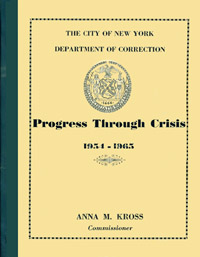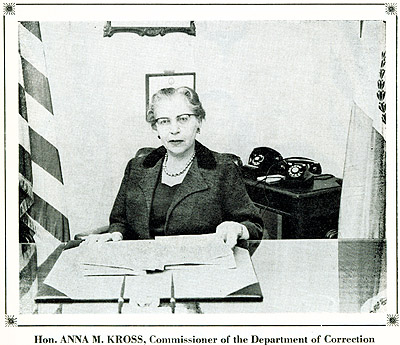
 |  |
CRISI5 UPON CRISIS has been the pervasive correctional lot of this Administration in the years since the beginning of 1951.
But sometimes these crises have been followed by a speeding up of remedial measures. Therein lies the story of PROGRESS THROUGH CRISIS in penology.
The close of twelve years of application toward the attainment of our goal is a time for stock-taking -- for a look backward and a look forward. In spite of our daily crises, we are pleased to be able to report that we have made progress in many areas.
Among knowledgeable modern penologists, the New York City Department of Correction is now recognized as outstanding among short-term institutions. In contrast, the Department was rated far down on the scale of modern penological standards on the first day of January in 1954 when this Administration took office.
Almost immediately we began a survey in depth of the situation in our correctional system.
Our appraisal and our recommendations were contained in our First Transmittal Letter, preface to the previous administration's Annual Report, issued and prepared by the present Administration during our first several months with only meager recorded data available.
We were faced, among other difficulties, with an over-whelming situation of demoralization:
The entire custodial staff had been deprived, by the preceding administration, of its insignia of authority, its badge. A backlog of over two hundred and fifty untried charges hung over all ranks.
In view of the realities of the situation, the Commissionerís first official act was to sit as Trial Commissioner and to hear and evaluate the charges, to restore the badges, and in general to set about raising the morale and the status of the uniformed forces -- an ongoing process whereby, as of the first of July of this year (1965), our Correction Officers at long last have achieved complete parity in pay and pension rights with all other uniformed forces of New York City.
The professionalization of the custodial force has also been considerably advanced, practically from scratch.
Whereas in 1954 no prerequisites of education or experience were required for Correction Officer candidates by the Civil Service Commission, at our request the very next examination provided new requirements: an academic minimum of a High School Diploma, plus a psychological examination and a police investigation.
We effected the first of our several liaisons with schools of higher education, and our own Correction Academy was opened in 1957 on Rikers Island.
Since the fall of 1961, in conjunction with the City University of New York and the Borough of Manhattan Community College, the Correction Center that we have established on Rikers Island has been able to offer courses leading to an Associate in Applied Science ( A.A.S.) degree in Correction Administration.
We are very proud to be able to announce that the best students, making the best grades, have been our own Correction Officers, many of whom are voluntarily preparing themselves for the true professional status that will be theirs when they have first earned their bachelorís degrees and have then attained their masterís degrees. It is our plan and our hope that in the not too distant future all Correction Officers will be required to have this same graduate status, on a professional par with that of their Parole, Probation, and Social Work colleagues.
[In printed book, the text continues on Page 18.]
|